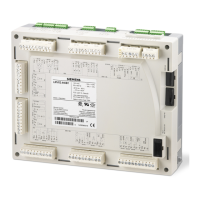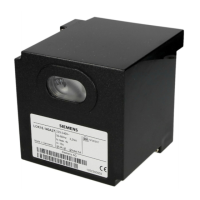LMV Series
Technical Instructions
LV5-1000
Menu Path Parameter Default Range Description
51.1
52.2
52.4
LEGEND - Password Access: (U)=User, (S)=Service, (O)=OEM, Shaded = Commonly Used, ** = Must Set, X = Has Function, / = Partial Function
LMV
StandardParam (U) Not Set
Adaption
very slow
slow
normal
fast
very fast
These are preset combinations of values for the for the internal load controller PID loop.
Adaption (autotune) is not performed with this parameter, but values found by adaption can
be used by selecting 'Adaption'. Options are:
Adaption: Values set and recorded here when adaption is performed
very slow: P = 3.4 % I = 273 s D = 48 s
slow: P = 4.7 % I = 250 s D = 44 s
normal: P = 6.4 % I = 136 s D = 24 s
fast: P = 14.5 % I = 77 s D = 14 s
very fast: P = 42.5 % I = 68 s D = 12 s
default: P = 14.5 % I = 120 s D = 0 s
The labels above refer to the response of the system (boiler, piping, loads) and not to the
LMV5 itself. Very slow gives the largest change in firing rate for a given pressure /
temperature change and is typically used on very large systems. Very fast gives the smallest
change in firing rate for a given pressure / temperature change. The default values work well
with most steam boilers.
x x x
P-Part (U) 14.5% 2-500%
P part of the PID loop. P is a type of proportional band around the setpoint, and the units are
percent. This % is based on 14.5 PSIG or 212 F, depending upon if the LMV5 is set for
pressure or temperature. Low values (2%) give an aggressive response and higher values
(100%) give a weak response. Setting this parameter too aggressively will cause the load
(firing rate) to hunt.
x x x
I-Part (U) 120s 0-2000s
I part of the PID loop. I is the integral (reset) function. This component serves
to eliminate
steady state error by looking at the accumulation of error over a period of time and
correcting for it. Low values (1s) give an aggressive response and higher values (1000s) give a
weak response. Setting this parameter too aggressively will cause overshoot of the setpoint.
Setting to 0 is not recommended for most applications since P and I are designed to work
together.
x x x
D-Part (U) 0s 0-1000s
D part of the PID loop. D is the derivative function. This component serves to eliminate
overshoot caused by the integral value, and also dampen the action of the P and I values.
Low values (1s) give a weak response and higher values (1000s) give an aggressive response.
Setting this parameter too aggressively will cause the load (firing rate) to hunt. Setting to 0
or to small values (10) works well for many steam boiler applications.
x x x
Params & Display>
LoadController>
ControllerParam>
ContrlParamList
NOTE: For most applications, PID values should be tuned so that the load v
alue does not change more than once every 10 seconds and the actual value trends within 5% of the setpoint.
SCC Inc. Page 29 Section 3

